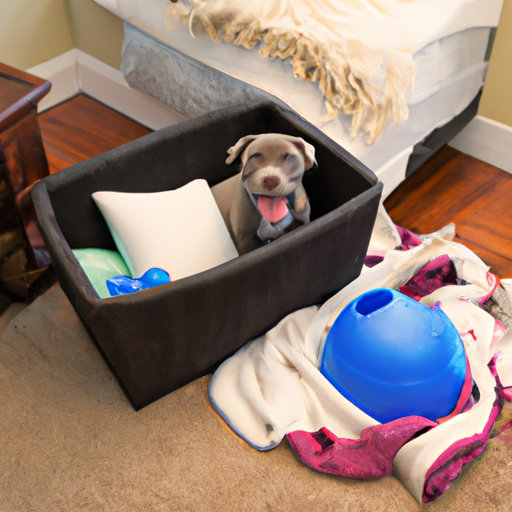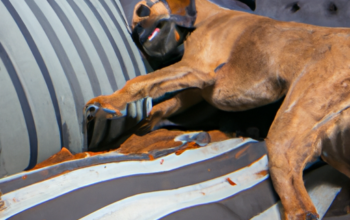Imagine the humble crate as a cozy den, providing your puppy with a sense of security and an important tool for house training.
It’s not just a confined space but also a sanctuary where they can retreat from the hustle and bustle of household activity.
Welcome to the art of crate training, an essential step in shaping your pet’s behavior.
As you embark on this journey, it’s crucial to select the right size crate and gradually introduce your furry friend to their new haven.
Developing a consistent training schedule is key to success while addressing whining and separation anxiety becomes inevitable part of this process.
This guide will equip you with techniques, tips, and strategies to effectively crate train your puppy in the most humane way possible.
So lean in as we unravel how you can lovingly transform that simple box into your pup’s personal castle!
Understanding the Benefits of Crate Training
You might wonder, ‘why bother with crate training?’ Well, it’s not just about containment. It’s also a fantastic tool for housebreaking and can offer your furry friend a safe and comfortable space of their own.
Crate training aids in establishing routines, making your puppy feel more secure while reducing anxiety-related behaviors. Moreover, crates simulate a dog’s natural instinct to seek out small, enclosed spaces for protection.
The benefits extend beyond the home too. If you travel frequently or visit the vet often, having a crate-trained dog eases these experiences by providing familiar surroundings. Consequently, your pup will be less stressed during such outings.
Remember that successful crate training requires patience and positive reinforcement. In this way, you aren’t just creating better behavior but also fostering trust between you and your pup.
Selecting the Right Crate Size
Choosing the perfect size of your furry friend’s new home is a delicate balancing act. The crate should be cozy, but not too cramped. It must offer enough space for your pup to move around comfortably.
Here are some guidelines to help you select the right crate size:
-
Room to Stand and Turn Around: Your puppy needs to be able to stand up without their head touching the top, and turn around with ease inside the crate.
-
Enough Space for Stretching Out: There should be sufficient room for your pup to stretch out when laying down, but avoid it being so big that they could designate one corner as their bathroom.
-
Growth Consideration: Consider your puppy’s expected adult size. Many crates come with dividers allowing you to adjust the space as your pup grows.
Remember, comfort and safety are key while crate training your puppy.
Familiarizing Your Pet with the Crate
Getting your pup acquainted with their new crate might take some time and patience, but it’s totally achievable. Let’s say, for instance, you’ve got a curious Labrador puppy named Max; introducing him to his crate could start by placing a few of his favorite toys or treats inside – before long, he’ll be exploring the space on his own terms and realizing it’s not so scary after all!
Here is a simple 3-step process to help familiarize your pet with their crate:
| Step | Action | Expected Outcome |
|---|---|---|
| 1. | Place Toys/Treats Inside | Piques curiosity and encourages exploration |
| 2. | Keep Crate Door Open Initially | Creates an inviting environment |
| 3. | Gradually Increase Crate Time | Promotes comfort and familiarity |
Remember, fostering a positive association with the crate is crucial for successful training. Patience is key!
Developing a Training Schedule
Feeling overwhelmed about creating a perfect training schedule for your furry friend? Don’t worry. Start by introducing the crate gradually for short periods during the day. Begin with 5-10 minutes and then increase the duration as your puppy gets comfortable.
Make meal times part of this routine too; feed your pup in their crate, starting with the door open and later closing it during meals once they’re at ease. Encourage nap time in the crate to foster positive associations further.
Remember, puppies need frequent bathroom breaks, so let them out every couple of hours, immediately after waking up, meals, or playtime. Be patient; accidents happen! Creating a consistent routine is key to successful crate training. With time and persistence, your puppy will view its crate as a safe haven instead of confinement.
Dealing with Whining and Separation Anxiety
It’s heart-wrenching to hear your little one whining in the night or struggling with separation anxiety. But remember, it’s a normal part of crate training and there are ways to ease their distress.
Start by understanding their feelings. Puppies whine when they’re anxious, scared, or lonely. They need time to adjust to being alone in the crate.
Establish a comforting routine before bed. This could include a final bathroom break, quiet playtime, and some cuddling.
Respond calmly if they whine. Avoid yelling or punishing them. Instead, reassure them softly that everything’s okay – your calm demeanor will help soothe them.
This approach helps your puppy associate the crate with positive experiences and reduces anxiety significantly.
Frequently Asked Questions
What should I do if my puppy refuses to enter the crate?
Like a knight coaxing a stubborn steed, patience is key. Entice your pup with treats or toys. Make the crate inviting, never a punishment area. Consistently practice this and they’ll soon see it as their safe haven.
Is crate training suitable for all breeds of puppies?
Yes, crate training is suitable for all breeds of puppies. However, it’s essential to tailor the process to your pup’s specific needs, considering their size, temperament, and inherent breed characteristics.
How long can a puppy stay in the crate at a stretch?
Like a baby needing nap time, your puppy shouldn’t stay crated for more than an hour per month of age. So, for instance, a four-month-old should not be left in the crate longer than four hours.
Can crate training affect my puppy’s social skills?
Crate training, when done properly, won’t harm your puppy’s social skills. It provides structure and safety. However, balance it with ample playtime, social interactions and exercises to ensure well-rounded development of your pup.
Are there any alternatives to crate training?
Absolutely! You’re not stuck with crate training. Alternatives like supervised free-roaming, baby gates, or playpens can be just as effective. They give your pup more freedom while still ensuring their safety and boundaries.
Conclusion
Crate training your puppy, much like learning to ride a bike, takes patience and consistency. It’s not always smooth sailing but the rewards are worth it.
You’ve learned how to choose the right crate size, make your pet comfortable with it, develop a routine, and deal with potential anxiety issues. Stick with it and you’ll have a happier, well-adjusted pup who sees their crate as a safe haven rather than a prison.



